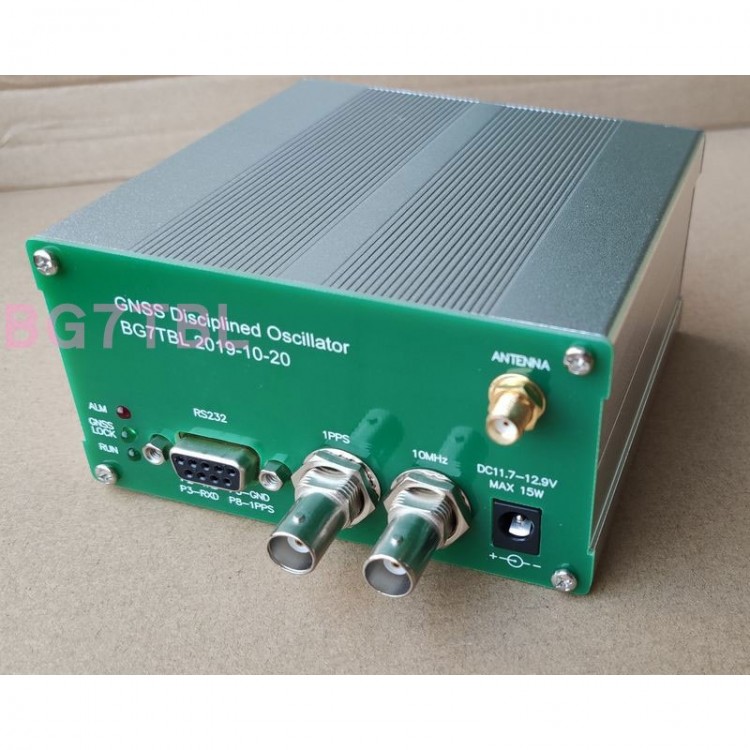
| Quantity | 3+ units | 10+ units | 30+ units | 50+ units | More |
|---|---|---|---|---|---|
| Price /Unit | $145.63 | $142.66 | $138.20 | $132.25 | Contact US |
GNSSD0-10MHz GNSS Disciplined Oscillator 20MHz Sine Wave 1Vrms Output GNSS Clock Support for GPS + BDS + GAL
Specifications:
- Model: GNSSD0-10MHz
- Item Name: GPSDO disciplined clock
- Power Supply: DC11.7-12.9V; ≤15W
- Antenna Power Supply: DC5V
- Compatible Satellite: depend on the option that you choose
- 1PPS Output Waveform & Amplitude: Square Wave, 3.3Vpp
- 10M Output Waveform Amplitude: Sine Wave, 1Vrms, (13dBm+-3dB)
- RS232 Output: NMEA Protocol, 9600BPS
- Accuracy: After GNSS is locked, frequency accuracy can reach 5E-9 (0.05Hz at 10MHz) within 5 minutes. Finally, accuracy will reach 2E-11 (0.0002Hz at 10MHz)
Package Included:
- 1 x GNSS Disciplined Oscillator
- 1 x AC110-220-DC12V Transformer
- 1 x 5m GPS Antenna
FAQ:
Q1: What is GNSS? What is GNSSDO?
A1: GNSS stands for Global Navigation Satellite System, which refers to the group of satellites that are providing signals from space used to transmit and position data. And by definition GNSS provides a whole Global Coverage. GNSS itself includes several positioning terms like GPS, GLONASS, Galileo, Beidou and other regional systems.
GNSSDO is an abbreviation for Global Navigation Satellite System disciplined oscillator. Use GNSS timing to adjust clocks to make clocks more accurate.
Q2: What is the basic principle of the GNSS Disciplined Oscillator? Why is it more accurate than the atomic clock?
A2: The basic principle of the GNSS Disciplined Clock: The standard time signal output by the GNSS module is generally a second pulse (1 pps) to control or compare the frequency of the constant temperature crystal oscillator, and then output a signal to correct the frequency error of the constant temperature crystal oscillator.
Since the output of the GNSS signal has no cumulative error and long-term accuracy is high, the tempered constant temperature crystal oscillator is more accurate than the atomic clock.
Q3: Where is the GNSSDO applied?
A3: Usually, it is used as a standard source of reference in cellphone base stations.
Q4: Can it be used without the antenna?
A4: Yes. Without antenna, the GNSSDO is used as an OCXO with keeping performance.
Q5: Where to place the antenna? Can it be used indoors or next to windows? What can we do if GNSS fails to lock?
A5: Please use it outdoors, facing to the sky directly. Please not use it indoors or next to windows. When the antenna is facing to the sky, at least 1 / 5 of the sky area should be available. Otherwise, GNSS signal and frequency accuracy are poor due to small sky area.
When GNS cannot be locked, please put it in an open space or place an iron plate on the back of the antenna. Properly adjustable the distance between the iron plate and the antenna, enhancing the signal.
Q6: What to do if the antenna is not long enough?
A6: Extension cables can be added. For example, we used an 8m extension cable to test application environment.
Q7: Can the antenna connect to your CATV's antenna?
A7: No. There is no GNSS signal in your CATV.
Q8: How to use the equipment?
A8: Connect it to the antenna and make the antenna facing to the sky. Connect to DC12V power supply. And BNC port will output 10MHz and 1PPS signals.
Q9: Can I change the supported satellite by myself?
A9: Please not modify. It may make the GNSSDO fail to work.
Q10: Can it be used in HiFi field and in speakers?
A10: With accurate frequency, improved acoustic details, enhanced resolution and reduced background noise, it can be used in audio field.
Q11: The output signal of the GNSSDO is 10MHz. Does it support my DAC with 16.9344MHz?
A11: Yes. You can use a converter to change 10MHz signal into 16.9344MHz signal.